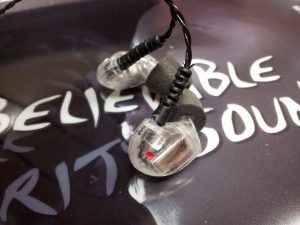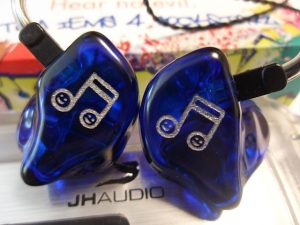 In-ear headphones are, to me, the best type of headphones. They strike the best balance of portability, sound isolation, comfort, and sound quality. I’ve been looking forward to writing this part in my series on Ultimate Listening – In Search of the Best Headphones.
In-ear headphones are, to me, the best type of headphones. They strike the best balance of portability, sound isolation, comfort, and sound quality. I’ve been looking forward to writing this part in my series on Ultimate Listening – In Search of the Best Headphones.
The first instalment had focused on the different type of headphones, and the continuing Part 2 discussed some technical aspects of headphones.
The choice of headphones type is as much a personal preference as it is the type of use case. So, although I like to write more in-depth about in-ear headphones, I’m not necessarily saying that they are the best for you. In-ear headphones are no doubt more portable compared with full-sized headphones, no argument here, but perhaps in the area of comfort, it may be possible that some people may disagree.
What are In-Ear Headphones?
First off, what exactly are in-ear headphones?
In-ear headphones are tiny headphones that stick directly into your ear canals. They deliver sound directly into your ear canal, and at the same time, provide some sort of isolation or seal against outside sounds, so that you hear your music more clearly and without the distraction from outside sounds.
Many people are familiar with earbud headphones. These are the type that are usually included free with your mobile phone, music player or other mobile gadget. Earbud headphones are not the same as in-ear headphones. The former sit in your outer ear, and don’t actually stick into your ear canal. The AKG K3003 and Q350 are in-ear headphones. The headphones that come with the Apple iPhone, even the latest iPhone 4S, are earbud headphones.
In-ear headphones are often also casually referred to as in-ear monitors. They aren’t, technically, the same thing. In-ear monitors are meant to refer to in-ear headphones with a wireless remote receiver, carried by stage performers, so that they can receive audio feedback from the sound mixing desk. Many people, however, just use the terms interchangeably.
Advantages of In-Ear Headphones
A key feature of in-ear headphones is that they sit inside your ear canal, and they deliver sound directly into your ear canals. They don’t go that deep inside your ear canal, so don’t worry about that. At the same time, in-ear headphones provide a seal against outside sounds, usually by using silicone ear sleeves or memory foam, which bridge the gap between the tip of the headphone that goes into your ear canal, and the walls of your ear canal.
The direct delivery of sound and sound isolation has several important advantages. Firstly, it is easier for the drivers to deliver the sound. There will be less interference and distraction from outside sounds. Music will sound cleaner and purer. The superior isolation will enable bass frequencies, in particular, to be more easily heard. You will also be less likely to push up the music volume in order to drown out any outside sounds.
In fact, because the music is so much clearer and more easily heard, you don’t have to play at high volumes. Ultimately, this will save your hearing. However, just bear in mind that good sound isolation is not always the best thing, because in some instances, you need to be aware of your surroundings.
Depending on your personal preference, in-ear headphones can also be more comfortable than, say, full-sized headphones. For example, I dislike full-sized headphones because of the headband that goes over my head. Some full-sized headphones also grip the head too tight. Others might slip out of position if you move around your head too much or too suddenly. Even earbud headphones can be prone to slipping out of your ears.
In-ear headphones, on the other hand, don’t easily fall out of your ear canals. I also feel they are more comfortable, because they are light, and the seals that hold the headphones in your ear canals are soft and flexible.
Universals and Customs
There are two types of in-ear headphones: universals and customs. Universals are ones that you can buy off the shelf. They are standard in make. So far, most of what I’ve written about refer to universals. Customs, while mostly similar to the universals, have some important differences.
Custom in-ear headphones are custom made to fit your ears specifically. Instead of having a standard headphone design, then using different sizes of ear sleeves or memory form to fit your ear canals, customs are made specifically to the size and shape of your ear canals. To make custom in-ear headphones, you’ve got to make an ear impression, then send the mould to the headphone manufacturer for them to custom make the headphone for you. The custom in-ear headphones you finally receive will fit your onto your outer ear and into your ear canals perfectly.
The perfect fit offered by custom in-ear headphones is a big advantage. They are often more comfortable to wear for long hours. Customs usually also provide good isolation, on par with silicone ear sleeves, although perhaps not as good as memory foam. There is some debate, however, whether any of these are true. Your mileage may vary.
The biggest hurdle with customs is that they sound great only when they fit your ears perfectly, so how do you audition such headphones? Before you buy it, there is nothing for you to try. In order to try, you’ve got to buy one.
That’s not all, even though customs are supposed to provide a perfect fit, it cannot be guaranteed. Maybe the ear impressions you supplied were not well made. Or perhaps the headphone manufacturer did not do a good job. You don’t know, until you’ve paid and received the final product. Worst yet, even if everything did get manufactured properly and the customs do fit you perfectly, what if the sound wasn’t quite what you were hoping for after all? There’s no refund or resale, since the customs are not going to fit anyone else.
As a result, some music listeners prefer to stay with universal in-ear headphones. Universals can also deliver superb performance. You can test these headphones before you buy them. Furthermore, you know exactly how they’ll sound like after you bought them, because it’s exactly the same thing as the one you tested.
Next Instalment
So we’ve just covered in-ear headphones. There’s really a lot more to know about them, but I decided not to go into too many details. I just wanted to get your interest in in-ear headphones, and if you like to know more, you know you can Google around for additional information.
My next instalment of this series will be on evaluating sound quality. This is the most difficult, most subjective, topic. It is also about the most important. So stay tuned. Please vote for me too, if you like what I’ve been writing!
This post was originally written as part of my participation in Omy.sg’s K3003 / The Sound of Luxury blog. I’m now reposting some of those posts, with some minor edits, on my own blog.
In Search of the Best Headphones: Part 1, Part 2, Part 3, Part 4


3 thoughts on “In Search of the Best Headphones (Part 3)”
View Comment Policy